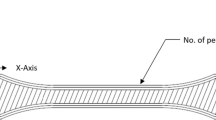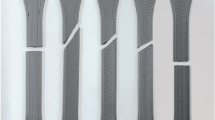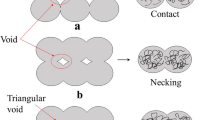Abstract
Addictive manufacturing (AM) or 3D printing has a huge potential in building products especially in a fabrication process. Fused deposition modelling is one of AM technologies that rapidly growing due to its ability to fabricate complex geometric parts with lower cost. However, this technique requires further improvement and further investigation due to the shortcomings such as poor surface finish and low mechanical strength. This work is to determine the best printing orientation to print a model for different mechanical properties, namely the tensile strength, impact strength, and hardness. ABS specimens are printed out according to the ASTM D638, ASTM D785, and ASTM D256 standard for each mechanical property. Experiments were conducted to investigate the mechanical properties. Samples printed in YZ (on edge) direction showed better tensile and impact behaviors than samples printed in XY and ZX directions. However, XY-axis (flat) is the best orientation if maximum hardness is the requirement.
Access provided by Autonomous University of Puebla. Download conference paper PDF
Similar content being viewed by others
Keywords
- Additive manufacturing
- Fused deposition modeling
- Fused filament fabrication
- Tensile strength
- Impact strength
- Hardness
1 Introduction
Additive Manufacturing (AM), also known as Layered Manufacturing or 3D Printing is a group of technologies that can produce a product with a physical prototype without any additional tooling and basically just rely on the Computer Aided Design (CAD) model. This is an invaluable characteristic because there is a need of quick manufacturing of the physical product of a designed part [1]. In recent years, the use of the 3D printing technology has been rapidly increasing and this phenomenon is foreseen. There are several technologies of 3D printing which are stereolithography, powder bed fusion/selective laser sintering, direct printing, binder printing, laminated object manufacturing and last but not least fused deposition modelling (FDM) or fused filament fabrication (FFF), each of the technologies has its own advantages and disadvantages [2].
Fused deposition modeling (FDM) or Fused filament fabrication (FFF) is one of the most popular technologies due to the relative low cost of the FDM printers. FDM is a process of layered deposition of plasticized build and support material supplied in form of a solid wire by an extrusion head as shown in Fig. 1. The common materials for FDM products are Acrylonitrile Butadiene Styrene (ABS), Polylactide (PLA), Polyethylene terephthalate (PET) etc.
Schematic of extrusion-based system [3]
During the last decades, additive manufacturing technology has been tested and used in various fields and industries such as automotive industry, aeronautical/aviation industry, medical applications and many more. The advantages that can be obtained from this technology are the flexibility of the manufacturing, and ability of mass customization. However, existing techniques have some weaknesses such as weak material combination, lower accuracy, limited choice of materials for certain techniques, and limited choice of bio-compatible materials (for medical application). Some of these shortcomings such as lower mechanical properties and accuracy can be avoided by knowing the proper selection of techniques and materials which affect the mechanical properties and dimensional accuracies of the printed object [4,5,6,7,8,9].
There are many investigations that investigated how printing parameters affects mechanical properties. In order to determine the impacts of build orientation on mechanical reliability on ABS 3D printed products, 47 tests were conducted based on ASTM D638 [6]. The experiment used Weibull analysis to analyze the fracture strength of the printed specimen in different orientation XY, XZ and C + 45 axis with a hole and without a hole. The orientation of the specimens printed is shown in Fig. 2. Scanning electron microscope was also used to scan the fracture surface of the specimen individually. They found that, sample printed at XZ-axis orientation has the highest fracture strength for both specimens with hole and without hole while C + 45 has the lowest fracture strength. Similar investigations were conducted by Tanoto et al. [7]. They reported strength, dimensional accuracy and printing speed of 3D printed ABS at three different printing orientations. The printing orientations were XY (flat), YX (on-edge) and ZX-axis (upright), as shown in Fig. 3. The tensile specimens were printed based on the ASTM D638 standard tensile test. YX-axis (on-edge) has the highest tensile strength which was 7.77 MPa compared to the other two which were 6.8 MPa for XY-axis and 3.31 MPa for ZX-axis. The fastest printing speed is ZX- axis followed by XY and YX-axis. For the dimensional accuracy, thickness, length, and width have been measured for all the test specimens. The closest specimen printed according to the standard is ZX-axis which the difference was 0.2 mm followed by XY-axis and lastly YX-axis. Tensile behavior for PLA sample printed at three printing orientations, 0°, 45°, 90° on horizontal plane was also investigated [8] and 45° was found to be the weakness in term of tensile behavior among all three printing orientations. Although most of the previous investigations were experimental based, theoretical model was successfully developed to understand and predict the ultimate tensile strength of FDM 3D printed PLA parts [10].
Specimens printing orientation [6]
Printing orientation from research [7]
Impact properties of 3D printed ABS samples at four different printing orientation were investigated by Roberson et al. [11]. The four orientations are provided in Fig. 4 and the tests were conducted according to ASTM standard D256. Scanning electron microscopy (SEM) was used to perform and explore the fracture surfaces of the specimens. Impact resistance and impact strength data were collected and analysed from the experimental. From the observation and results, Type 2 printing orientation has the best impact resistance compared to the rest while Type 4 is the worst. The result same goes for impact strength where Type 2 is the best and Type 4 is the lowest among all.
Printing orientation for research [11]
In other research work, Chacón et al. [12] investigate the effect of build orientation, layer thickness and feed rate on the mechanical behavior of 3D printed PLA samples. Result shows flat and on-edge orientation have highest strength and stiffness while upright orientation shows the lowest mechanical performance. Based on their observations, there are two main failure modes, which are (i) inter-layer failure and (ii) trans-layer failure, which also relates to layer-to-layer bonding and direction of filament deposition.
Previous works reported that printing orientations has effect on mechanical properties. However, most of the previous works focused on the effect of printing orientations on only one mechanical property. Furthermore, different machines and different materials were used in separated work, and this caused direct comparison of results from different works is challenging. Therefore, the objective of this study is to investigate the effects of printing orientation on tensile strength, hardness, and impact strength of FDM printed samples from a same machine and same material. Current work is aimed to determine the best printing orientation (XY, YZ, ZX-axis) for three different mechanical properties.
2 Methodology
2.1 Printer and Filament
The 3D printer model used was 3D Printer Ultimaker 2+ and the filament chosen for this experimental was Acrylonitrile Butadiene Styrene (ABS) filament of diameter 2.85 mm.
2.2 Sample Preparations
3D printed samples for tensile, hardness, and impact were prepared according to the standard ASTM D638, ASTM D256 and ASTM D785, as shown in Fig. 5. The cross-sectional area of hardness sample is 40 × 40 mm2 with height of 6.4 mm. The Creo CAD was used to create the models according to the dimension required before the file was being transferred to a slicing software, Ultimaker Cura. Ultimaker Cura was used in slicing the model file that has been designed into layers and generating the g-code. Printing parameters for all samples were remain constant such as layer height of 0.15 mm, the nozzle size of 0.4 mm in size and infill of 100%. Besides, build plate adhesion was activated to enable easy removal of printed parts. Heated bed was set at 90 °C and nozzle temperature was 260 °C. The parameter investigated in this work was printing orientation. Three different printing orientations XY-(flat), YZ-(on edge) and ZX-axis (upright) were studied and printing orientations for tensile samples are illustrated in Fig. 6. No post-processing was applied on printed samples before mechanical test.
3 Experimental Testing
3D printed samples were tested by using three different tests, tensile strength, impact strength and hardness test.
3.1 Tensile Strength Experiment
Universal Testing Machine Quasar 25 was used to perform tensile test for total 18 samples at three different printing orientation (6 tests are done for each orientation). The machine’s software GraphWork 5 was used to collect data. The data of each testing was then tabulated and averaged.
3.2 Impact Strength Experiment
For impact strength, Impact Tester CH/IMP-300TL was used. The specimen was placed on the designated area and the impact hammer was controlled by a remote. A total of 18 different tests was conducted with 6 tests per orientation. The results were obtained from the computer connected to machine, and the average value for each orientation was used for discussion.
3.3 Hardness Experiment
The hardness tests were conducted on a Sinowon hardness tester. A Rockwell test procedure was used to measure the hardness of the 3D printed samples. Time for the indentation depth is fixed for 5 s for all the experiments. The results were obtained digitally from the screen of the machine and 18 tests were carried out for the experiment. Six tests per orientation were conducted and the hardness values were averaged and plotted in a graph for the comparison and shown in the discussion section.
4 Results and Discussion
4.1 Tensile Strength
Tensile results, including yield strength, ultimate tensile strength (UTS) and breaking point at three different printing orientations are shown in Fig. 7. Sample printed at YZ-axis shows the best ultimate tensile strength with the average reading of 15.45 MPa and followed by printed at XY-axis with 11.79 MPa and lastly printed at ZX-axis with 10.29 MPa. However, XY-axis is slightly higher in yield strength and followed by YZ-axis and lastly ZX-axis. Thus, specimen printed at YZ-axis is the best printing orientation for tensile strength followed by XY-axis and ZX-axis. ZX-axis is the weakest because ABS layer patterns produced under this orientation were perpendicular to the direction of tensile force, hence, bonds between layers can be separated easily than the other two orientations. Similar results for were reported for ULTEM® 9085 material [9], ABS [13], and PLA-Sugarcane bagasse fibre composite [14]. Liu et al. reported that ‘vertical’ printed sample has lower tensile strength than the ‘parallel’ printed sample, and it was caused by poor bonding between line and line [14]. YZ-axis has the highest tensile strength, and this is because it has more layers than XY-axis even they are parallel to the tensile force (Fig. 8), as suggested by Tanoto et al. [7]. Current work confirms that printing orientation has significant effect to the tensile force of the specimen. If the specimen has more layers during printing, and the orientation is parallel to the tensile force, it can hold much better. This finding can be used to optimize tensile behavior of model which required tension force.
Comparison tension force of XY-axis and YZ-axis [7]
4.2 Impact Strength
As shown in Fig. 9, YZ-axis has the highest average impact toughness which is 1.55 J/cm2 followed by XY-axis at 1.07 J/cm2 and ZX-axis which is the lowest at 0.27 J/cm2. ZX-axis is the lowest because ZX-orientation produced layer patterns that were perpendicular to the impact force, therefore, this caused the bonds between layers were easily separated than the other XY and YZ orientations. YZ-axis has the highest impact toughness because it had more layers than XY- axis that were parallel to the impact force. Sample printed at YZ- axis has more layers due to the specimen height during printing under this printing orientation. Additional layers acted as additional resistance to impact force. The best printing orientation for impact strength is also the best printing orientation for tensile strength, as reported in previous section, and similar to previous works [13]. Figure 10 shows the printing point and the height of the specimen that makes the specimen stronger in terms of break energy. Higher height means more layer during printing because layer thickness for all specimens is fixed. Therefore, that is why YZ-axis shows a higher result compared to XY-axis. The more layers used during the printing, the stronger it is to break while the printing orientation must be parallel to the impact force. Hence, YZ-axis shows the best result and is consistent with previous study [11]. Hence, they orientation of printing plays a big part because different orientation will give different layers of the specimen. The specimen dimension is 125 mm × 12.7 mm × 10 mm. Different orientation will give different printing height with the same dimension for each specimen. Increasing in height means increasing of layers during printing.
4.3 Hardness
Figure 11 shows that XY-axis has the highest hardness which is 87.73 HRB followed by YZ-axis which is 73.5 HRB and lastly is ZX axis which is the lowest at 65.9 HRB. The printing orientation for hardness sample is shown in Fig. 12. XY-axis orientation is the strongest because it has the strongest foundation during printing due to larger cross-sectional area of 40 × 40 mm2 compared to the rest. Outer layer from another end to another end during layer printing is much closer and make it stronger in term of hardness compared to the rest which has small printing cross-sectional area and result to a weaker foundation of the model.
ZX-axis orientation is the weakest as it was printed vertically which is weaker in foundation and has many layers to be printed in a small area and result to a weaker bond between the print layers compared to XY-axis orientation. Therefore, bigger cross-sectional area in printing orientation produces a greater hardness for the model. This result is in different pattern compared to the tensile and impact strength as it depends on how big the cross-sectional area of the printed object is.
5 Conclusion
Current works have successfully identified the best printing orientation for ABS to optimize tensile strength, impact strength, and hardness. The best printing orientation for tensile strength and impact strength is YZ-axis which achieved 15.45 MPa, and 1.55 J/cm2 respectively, while the best printing orientation for hardness is XY-axis at 87.73 HRB. The findings also suggests that the higher the tensile strength of the model, the stronger the impact strength of the model. With the results obtained, it proves that printing orientation affects the mechanical properties and qualities of the models. Hence, a best model in terms of mechanical property can be printed by using the optimised printing orientation if the purpose of model is known. Additional investigations such as more orientations and reinforcement can be tested to improve the strength of 3D printed samples.
References
Ahn SH, Baek C, Lee S, Ahn IS (2003) Int J Mod Phys B 17:1510
Štefanić I, Raos P, Samardžić I, Tintor B, Musser E (2012) Teh Vjesn 19:459
Gibson I, Rosen DW, Stucker B (2010) Additive manufacturing technologies rapid prototyping to direct digital manufacturing. Springer, Boston, MA
Giri J, Chiwande A, Gupta Y, Mahatme C, Giri P (2021) Mater Today Proc
Cherkia H, Kar S, Singh SS, Satpathy A (2020) Lect Notes Mech Eng 1
Keleş Ö, Blevins CW, Bowman KJ (2017) Rapid Prototyp J 23:320
Tanoto YY, Anggono J, Siahaan IH, Budiman W (2017) AIP Conf Proc 1788:1
Vǎlean C, Marşavina L, Mǎrghitaşl M, Linul E, Razavi J, Berto F (2020) Procedia Struct Integr 26:313
Zaldivar RJ, Witkin DB, McLouth T, Patel DN, Schmitt K, Nokes JP (2017) Addit Manuf 13:71
Yao T, Deng Z, Zhang K, Li S (2019) Compos Part B Eng 163:393
Roberson DA, Torrado Perez AR, Shemelya CM, Rivera A, MacDonald E, Wicker RB (2015) Addit Manuf 7:1
Caminero MÁ, Chacón JM, García-Plaza E, Núñez PJ, Reverte JM, Becar JP (2019) Polymers (Basel) 11
Patadiya NH, Dave HK, Rajpurohit SR (2020) In: Shunmugam M, Kanthababu M (eds) Advances in additive manufacturing and joining. Lecture notes on multidisciplinary industrial engineering. Springer, Singapore, pp 301–307
Liu H, He H, Peng X, Huang B, Li J (2019) Polym Adv Technol 30:910
Acknowledgements
We wish to thank our laboratory staff, Mr. Elyas Budiman bin Rahmat for the technical assistance and the university for the laboratory facilities. This research work was conducted as preliminary work for a project funded by Ministry of Higher Education Malaysia (MOHE). The third author would like to acknowledge MOHE for the FRGS grant with code FRGS/1/2019/TK03/HWUM/02/1.
Author information
Authors and Affiliations
Corresponding author
Editor information
Editors and Affiliations
Rights and permissions
Copyright information
© 2022 The Author(s), under exclusive license to Springer Nature Singapore Pte Ltd.
About this paper
Cite this paper
Mohd Khairul Nizam, M.A.N.b., Ismail, K.I.b., Yap, T.C. (2022). The Effect of Printing Orientation on the Mechanical Properties of FDM 3D Printed Parts. In: Abdul Sani, A.S., et al. Enabling Industry 4.0 through Advances in Manufacturing and Materials. Lecture Notes in Mechanical Engineering. Springer, Singapore. https://doi.org/10.1007/978-981-19-2890-1_8
Download citation
DOI: https://doi.org/10.1007/978-981-19-2890-1_8
Published:
Publisher Name: Springer, Singapore
Print ISBN: 978-981-19-2889-5
Online ISBN: 978-981-19-2890-1
eBook Packages: Chemistry and Materials ScienceChemistry and Material Science (R0)
















